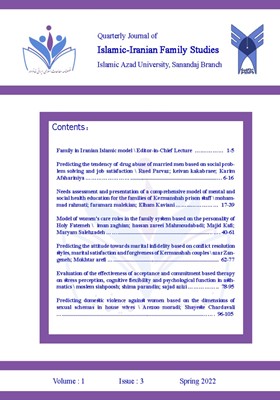-
-
List of Articles
-
Open Access Article
1 - Comparing the effectiveness of metacognitive therapy and behavioral activation therapy on cognitive-emotional regulation in women with dysthymic disorder
Majid Jamehbozorgi Seyyed ali Aleyasin hasan heidari Hossein Davoodi -
Open Access Article
2 - The effectiveness of the psychological package of pre-marital education on the problem-solving styles of couples applying for marriage
Farshad Zhian Mohammad Hatami Mojgan Ahgah Harris -
Open Access Article
3 - Providing a family-oriented problem-solving training program for parents of Down syndrome children
Maryam Seidy Gholam Ali Afrooz Leila Kashani Vahid aliakbar arjmandnia keivan kakabraee -
Open Access Article
4 - Comparison of the effectiveness of individual and family-centered schema therapy, with and without supportive therapy, in reducing the symptoms of patients with borderline personality disorder
kianoosh azizi mokhtar arefi omid moradi -
Open Access Article
5 - The effectiveness of family-centered mindfulness-based therapy on resilience and rumination of mothers of children with specific learning disabilities
Masoumeh Felegari Afshin Salahian Hassan Gharibi somayeh saedi Shayeste Chardavali -
Open Access Article
6 - The effectiveness of Treatment based on reducing extramarital relationships on marriage instability and family functioning in couples
zakieh nasiri Nazanin Honarparvaran Fatemeh Javadzadeh Shahshahani Javadzadeh Shahshahani Siamak Samani -
Open Access Article
7 - Validation of educational model of intimacy and marital satisfaction among incompatible couples with emphasis on Ellen Langer's approach
leila yeganehfard alireza afshani saeed vaziri -
Open Access Article
8 - Predicting domestic violence against women based on the dimensions of sexual schemas in house wives
Arezoo moradi Shayeste Chardavali
-
The rights to this website are owned by the Raimag Press Management System.
Copyright © 2021-2025







